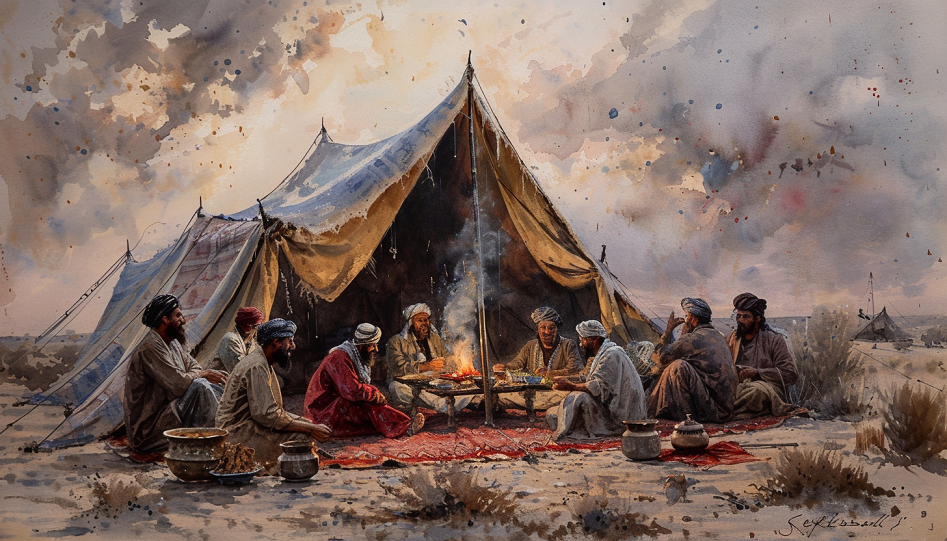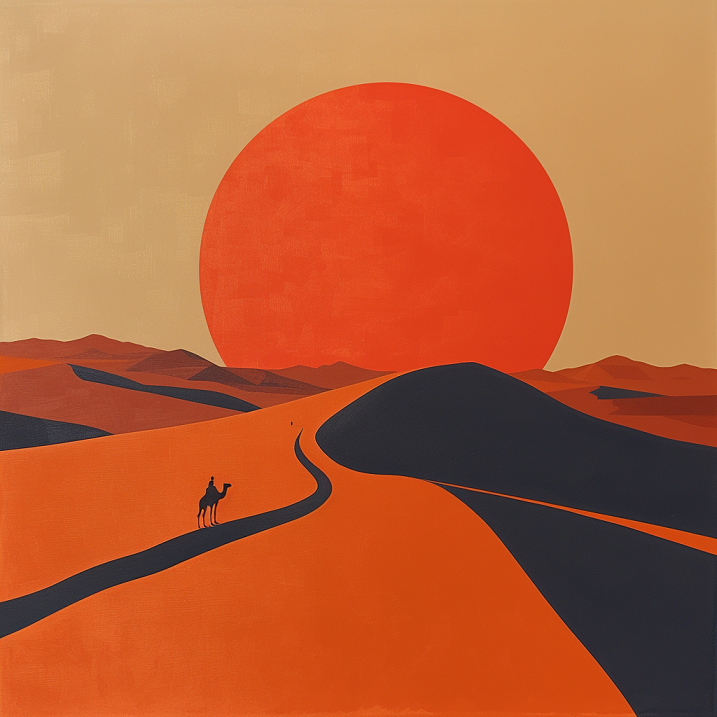In the early 20th century, Harry St. John Philby, an eminent British explorer and writer, embarked on a remarkable journey into the heart of Saudi Arabia, an adventure documented in his book “Heart of Arabia.” This expedition, set against the backdrop of the Arabian desert’s vast expanse, provides insightful observations into the geography, tribal dynamics, and historical legacies of the region. Philby’s narrative, rich with descriptions of the Arabian landscape, from the featureless lumpy country to the intriguing Ghar al Shuyukh, and interactions with tribes such as the Ibn Da’ath section of Qahtan, paints a vivid picture of a land teeming with culture and tradition. His work not only contributes to our understanding of Saudi Arabia’s geographical and cultural landscape but also highlights the significance of places, people, and tribes encountered during his travels. Through Philby’s eyes, readers are invited to explore the nuanced complexity of Saudi Arabia, a land where history and modernity converge.
- Survival and adaptation strategies are central to navigating the harsh desert conditions.
- The journey highlights the complex dynamics of tribal leadership and territorial boundaries.
- Philby’s interactions with the tribes provide insights into the cultural and historical context of Saudi Arabia.
- The natural beauty and biodiversity of the desert challenge common perceptions of it as barren.
- The legacy of external powers like the British and the Ottoman Empire is evident in the tribes’ perceptions.
- Preparation and knowledge of the environment are crucial for successful exploration.
The Journey Commences
The initial phase of Philby’s expedition unfolds across a terrain that could best be described as “featureless lumpy country” interspersed with occasional “grassy depressions”, setting the stage for a journey of discovery and endurance. The travellers’ path, aimed towards a low, dark ridge on the horizon, culminates at the foot of Ghar al Shuyukh, a landmark steeped in royal history and named “royal cavern” for its visits by Ibn Sa’ud or his ancestors. This natural shelter, merely an overhanging ledge of rock standing forty to fifty feet high, offered the weary explorers a much-needed respite from the relentless desert sun. Philby’s account of reaching this site after a grueling twenty-five-mile march from their starting point encapsulates the expedition’s essence—a relentless quest for understanding amidst the Arabian desert’s daunting vastness. “Having marched throughout the heat of the day under a sun, which was sufficiently trying as it beat upon the stony soil, we were not sorry to be at the end of our journey,” Philby remarks, highlighting the physical toll of their journey and the simple yet profound relief found in the cavern’s shade.
Preparations and Provisions
In anticipation of the demanding conditions of the Arabian desert, Philby and his caravan meticulously prepared for their journey, highlighting the significance of self-sufficiency in such a harsh environment. Understanding the necessity of water in the desert, they carried six water-skins exclusively for their use, a decision informed by prior experiences with the Badawin’s lack of foresight on similar expeditions. To further mitigate the risk of scarcity, they supplemented their supplies with a sack of flour and another of rice, ensuring a level of food security for the common good of the group. This strategic preparation was born out of a keen awareness of the desert’s unforgiving nature and the imperative to plan judiciously for survival. Philby notes the importance of these arrangements: “As before, we had our own commissariat arrangements,” underscoring the lessons learned from previous travels and the critical role of adequate provisioning in the success of their desert crossing.
Composition and Leadership of the Caravan
The composition and leadership of Philby’s caravan were pivotal to the journey’s dynamics and overall success. At the helm of the caravan’s arrangements was ‘Amir, a Dausari by origin who had settled into town life through generations of residence at Hufuf. ‘Amir’s dual role as a guide for trading caravans and a joint owner of camels provided him with a unique blend of skills and knowledge essential for navigating the trade routes and desert landscapes. Despite his experience, ‘Amir’s leadership was often overshadowed by internal dynamics and rivalry within the group, particularly with ‘Aidh, a fellow townsman known for his crafty demeanor and overbearing presence. This interplay of personalities within the caravan’s leadership highlighted the complexities of managing a diverse group through challenging terrains.
Philby’s observations shed light on the nuanced relationships and power structures within the caravan: “‘Amir, alone of the whole party, had an intimate knowledge of the country we traversed and was always ready to impart it.” This acknowledgment of ‘Amir’s expertise juxtaposed with the ongoing sparring with members of the escort, who derived their authority directly from ‘Abdullah ibn Jiluwi, the vicegerent of Ibn Sa’ud, illustrates the delicate balance of respect, knowledge, and power dynamics at play.
Furthermore, the caravan’s composition, including over thirty camels and about twenty-five persons, underscored the expedition’s scale and the logistical considerations involved in such an undertaking. The inclusion of ‘Abdullah’s guards as a personal escort not only provided security but also added a layer of political and social complexity to the journey. Through Philby’s lens, the caravan emerges not just as a group of travelers but as a microcosm of Arabian society, with its intricate web of relationships, alliances, and hierarchies navigating through the desert in pursuit of common goals.
Encounters in the Desert
Philby’s journey through the desert was marked by encounters that provided valuable insights into the nomadic lifestyle and the ecological balance of the Arabian landscape. One significant interaction was with the Ibn Da’ath section of the Qahtan tribe, whose movements across the desert in search of new pastures illustrated the nomadic tribes’ adaptive strategies to the harsh desert conditions. The sight of droves of camels moving leisurely northward in search of sustenance highlighted the perpetual quest for resources that defines life in the desert.

The expedition’s path also brought them near Wadi Faruq, a broad valley that served as a natural drainage area amidst the desert. Philby’s curiosity about the valley’s geological features and its role in the desert’s ecosystem underscores the importance of water sources for both the nomadic tribes and the wildlife of the region. Despite the lack of precise information on the wadi’s drainage, its presence is a testament to the hidden complexities and surprises of the Arabian desert landscape.
Moreover, the discovery of the first trees since leaving Hufuf near Wadi Shajara offered a moment of respite and wonder. “These were the first trees we had seen since leaving Hufuf, and are the only ones visible from the road in all the desert between the Hasa and the Turabi plain beyond Abu Jifan,” Philby notes, underscoring the rarity and preciousness of such sights in the vast desert. This encounter not only provided physical shade but also symbolized the desert’s ability to sustain life in its most unexpected forms.
Traversing the Eastern Desert
Traversing the Eastern Desert was a critical phase of Philby’s expedition, marked by the transition from the steppe to the sand dunes of the Dahana. The journey through Malsuniyya, a connecting link between these two distinct landscapes, showcased the gradual shift in the desert’s character. Malsuniyya, described as a narrow strip of desert herbage leading into low, gently undulating down-country, was strewn with limestone boulders, signifying the harsh and varied terrain of the Arabian Peninsula.
The expedition’s path then led them into the Jasra, a causeway of similar formation that runs like a wedge into the Dahana, presenting the first real challenge posed by the sand dunes. Philby describes this moment of entry into the Dahana with a sense of awe and apprehension: “At last we had set foot upon the Dahana and passed over the first ridge close by a nameless dilapidated cairn.” This marked their full plunge into the desert’s heart, where navigation required a blend of experience, intuition, and technology, such as a compass, to traverse the shifting sands successfully.
The presence of the Rijm al Shuwair cairn as a navigational aid in this sea of sand underscores the ancient methods of desert wayfinding. Despite the challenges, Philby notes that “the terrors of this barrier of sand have been grossly exaggerated,” referencing their crossing at a point previously navigated by Palgrave fifty five years before. This observation suggests a reconsideration of the Dahana’s impassability and hints at the desert’s dynamic and ever-changing nature, challenging and reshaping the perceptions of those who dare to traverse it.
Cultural Insights and Historical Context
The cultural insights and historical context gleaned from Philby’s journey through the Arabian desert provide a rich tapestry of the region’s social fabric and long-standing traditions. The leadership structures and territorial boundaries of various tribes encountered along the way, such as the Bani Hajir, Manasir, Murra, and Bani Khalid, offer a glimpse into the complex interplay of power, loyalty, and identity that defines tribal dynamics in Saudi Arabia.

Philby’s interactions with these tribes and observations of their lifestyles underscore the deep-rooted connection between the people and their land. For instance, the Bani Hajir‘s roaming from the Kuwait border to the Qatar coast and their intricate social hierarchy highlight the nomadic nature of tribal life and the importance of lineage and territory in maintaining social order. Philby’s account, “Though shaikhs of a great tribe, Dhib and his son wore but a cotton smock and went unshod,” reflects the humility and simplicity that characterise the everyday lives of even the most respected tribal leaders.
Furthermore, Philby delves into the broader geopolitical landscape, noting the tribes’ perceptions of external powers such as the British and the Ottoman Empire. A Bahrain astrologer’s prediction of the “victory of the Bani Asfar or white folk over the Muslimin” illustrates the region’s engagement with and anxiety over colonial and imperial forces shaping the Middle East’s fate. These insights into the tribes’ views and speculations reveal the complex layers of interaction between local traditions and global influences.
Harry St. John Philby’s expedition into the heart of Saudi Arabia, as detailed in “Heart of Arabia,” offers a compelling glimpse into a land of stark contrasts and enduring traditions. Through his vivid descriptions and insightful observations, Philby not only charts the physical landscapes of the Arabian desert but also navigates the complex social and historical currents that define this region. His journey underscores themes of adaptation, resilience, and the quest for knowledge, revealing the desert not as an empty expanse but as a vibrant tapestry of life.
Q: What was the main purpose of Harry St. John Philby’s expedition?
A: To explore and document the geography, tribal dynamics, and historical contexts of the Arabian desert.
Q: How did Philby and his caravan prepare for their journey through the desert?
A: By carrying essential supplies like water and food, and learning from past experiences with the Badawin.
Q: Who led the arrangements for Philby’s caravan?
A: ‘Amir, a Dausari by origin and a knowledgeable guide with extensive experience in desert navigation.
Q: What significant natural feature did Philby’s expedition encounter?
A: The expedition encountered the Dahana sands, challenging but less formidable than anticipated.
Q: What insights did Philby provide about the tribes of the Arabian desert?
A: He offered detailed observations on their social structures, lifestyles, and interactions with external powers.
Q: How did Philby’s journey contribute to our understanding of the Arabian desert?
A: It challenged stereotypes, revealing the desert’s rich biodiversity, cultural depth, and historical significance.

